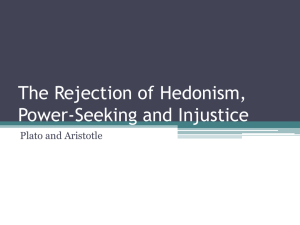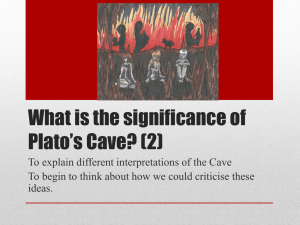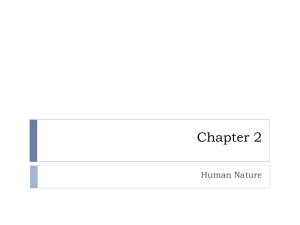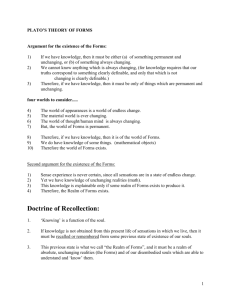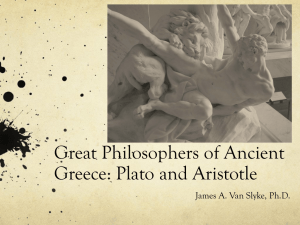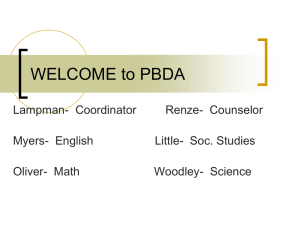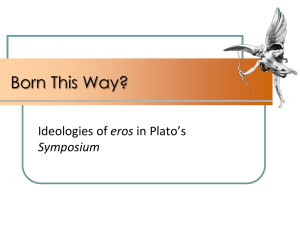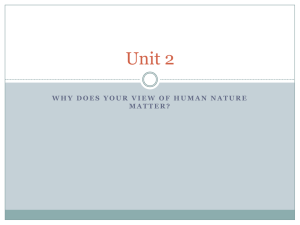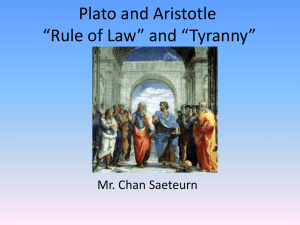Plato`s Forms and Criticisms
advertisement
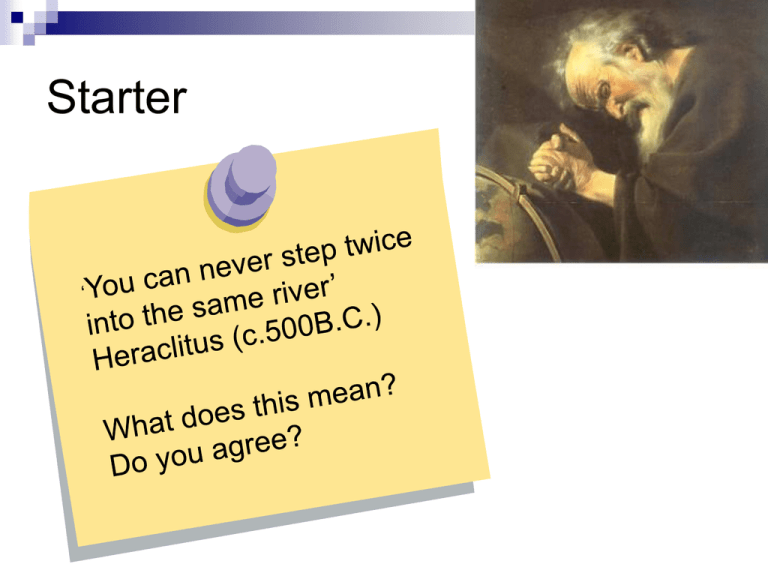
Starter Lesson Objectives By the end of this lesson you will: Have refreshed your knowledge of the Allegory of the Cave Understand Plato’s Theory of Forms Be able to reflect on the strengths and weaknesses of the Theory Think back to what we learned in or first lesson. What is real? How do you know? Plato’s Forms attempts to answer this question in the Allegory of the Cave through the World of the Forms. Plato’s Theory of Forms The idea of the Forms is illustrated in the Allegory of the Cave. Plato believed true reality existed beyond normal perceptions of the world. What we perceive around us is a shadow of this truth. Plato’s Theory of Forms According to Plato the world we live in is a poor imitation of the real world. Our world is constantly changing and we rely on our senses to understand what is going on. You are not the same person you were 3 years/hours/seconds ago, cells are forever changing and ideas flit through our minds. Plato was therefore sure that the real world is outside the one we live in. This real world is unchanging and eternal. It is the world of ideas not senses, where there are perfect forms of the things we know on earth. Card Sort Into those of the Material World, and those of the World of the Forms. The Material World The World of the Forms Transitory- moves in time and space Outside of time and space Relative Real and absolute Changing Unchanging Impermanent Permanent Superficial What matters most Contradictory- are subject to opinion Sensory NO-contradiction- they are NOT subject to opinion Beyond the senses Can be measured Immeasurable Imperfect Perfect Activity Draw a dog or write down the essential qualities that define a dog It is impossible to get a clear definition and rule out other animals at the same time. A 3 year old would have no problem distinguishing a dog from another animal. The child is identifying the form whilst we are getting bogged down with the details. The Form is not a shape, it is the essence of an object. A dog and all dogs have a degree of ‘dogginess’ due to participating in the form. Reading philosophy Read the information sheet on the word of the forms. Use a highlighter and then summarise each paragraph in the margin. Does it raise any questions? Get to the end and then think ‘so’? Let’s think about Beauty? What comes into your mind when you think of the word ‘beauty’? With the person next to you talk about something or someone who you would describe as ‘beautiful’ The beautiful person participates or shares in beauty with all other beautiful things, but beauty itself is beyond our normal perception. “Her eyes are too close together” – we can recognise that she falls short of beauty and thus understand the concept of beauty due to our prior knowledge, yet we have not ever experienced a perfect example of beauty. Summing up... The Material World (our world) Here the material objects exist, subject to change and decay. They take their identity from the way that they conform to their corresponding idea in the world of the Forms. The material world is a shadow of the ‘real’ world of the Forms. The World of the Forms Here the patterns for the objects and concepts for the material world exist in a state of unchanging perfection. It is the job of the philosopher to break free from the shackles of the material world and find the world of the Forms. Task Draw a cartoon/diagram/picture of the philosopher looking up to the sun surrounded by lesser ‘earth-bound mortals’. Demonstrate your understanding of Plato’s Theory of Forms by using arrows to explanations or other images if you wish. This will be a good revision aid later. Traffic lights… Could you explain the Allegory of the Cave in your own words? Do you know the difference between the material world and the world of the Forms? Could you explain why Plato says the world we live in is not the real world? Could you give a definition of a Form? Do you understand Plato’s Theory of the Forms? Task In your groups Re-create/animate Plato’s Cave and ideas about forms using the PlayDoh and film it Plato’s Allegory of the Cave is symbolic - each of the different ideas must be explained You have 30 minutes before we move on to some more hard stuff!! Create a table of strengths and weaknesses Strengths Weaknesses Evaluating the World of Forms – Plato’s understanding Plato is going to argue that through the use of reason or our mind we can recall what our soul remembers from the WoF. We recognise beauty, truth or justice because we have seen this before. At face value this seems plausible. The task of the philosopher is to seek out true reality by training himself not to see the ‘shadows’ of the physical world around him. Mini whiteboards Criticise Plato! How many criticisms can you come up with in your groups? Basic Problems THERE IS NO PROOF OF THE WORLD OF FORMS! We only have Plato’s theory and a flawed analogy to explain the WoF. (1902 – 1994) : Believed that Plato sought permanence in the WoF as a way of dealing with the uncertainty of life. Plato couldn’t accept that TRUE REALITY can change – someone like Popper would ask ‘Why can’t true reality change?’. If Popper is right then there is no need to posit the existence of another realm to find the truth. Popper Another Problem.. Aristotle had several criticisms of Plato, particularly the Form of the Good. He suggested that Good comes in so many varieties that there cannot be one Form of it; Goodness of a person is different from the Goodness of a shovel. A person may be a Good person but a bad shovel. In essence Aristotle was looking at purpose as the definition of whether something was good, in other words something was good in relation to something else – a good knife is one that cuts, a bad one doesn’t fulfil its purpose as something that cuts. More problems Aristotle also suggested that something does not have to be eternal to be pure. Something white does not become more white if it is eternal – eternity and whiteness are different qualities (meaning that the realness of something does not depend on it remaining unchanged as Plato tried to suggest). The Forms have no real practical use. They cannot be applied in the physical world. Traffic lights… Could you explain at least 3 criticisms of the WoF? Imagine Meeting Plato Come up with 3 good questions that you would ask him to help you understand his theories. Er, excuse me, Mr Plato?

